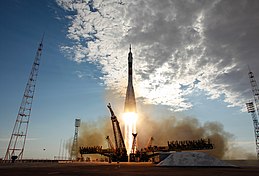|
Soyuz TMA-M
The Soyuz TMA-M was a spacecraft developed by Energia and operated by Roscosmos for human spaceflight. Introduced in 2010, it was a revision of the Soyuz spacecraft with upgrades over its predecessor, the Soyuz TMA. It flew a total of 23 missions from 2010-16, all carrying astronauts to the International Space Station (ISS). It was replaced by the Soyuz MS. DesignThe primary difference between the Soyuz TMA-M and the earlier Soyuz TMA was the removal of several pieces of outdated equipment, many of which were no longer in production. These included the 70-kilogram (150 lb) main digital computer, called Argon,[1] and its analogue avionics. They were replaced with a new digital computer, the TsVM-101 and digital avionics.[2] There were also changes to the spacecraft's structure, such as replacing the magnesium alloy used in the instrument module frame with an aluminium alloy,[2] for easier manufacture.[3] In combination, the changes reduced the vehicle's total mass by 70 kilograms (150 lb).[3] Additionally, power consumption was reduced throughout the ship, improving its overall efficiency.[2] FlightsTwo development flights were launched: Soyuz TMA-01M on Oct 7, 2010 and Soyuz TMA-02M on Jun 7, 2011. NASA astronaut Scott Kelly, who flew on TMA-01M, praised the spacecraft's new digital displays, noting that they made flying easier and less demanding.[4] The third mission, Soyuz TMA-03M, launched on 21 December 2011 and was used for qualification tests. In addition to verifying the nominal operation of the spaceship, the testing included verification of off-nominal modes, such as manual attitude control, issuing of orbital manoeuvring pulses using four berthing and attitude thrusters, and flying around the ISS in manual control mode.[5] Thereafter the TMA-M entered regular service, where it was used for supply and crew rotation flights to the ISS. The TMA-M variant flew another 20 missions from 2012-16, at a cadence of four times a year, all to the ISS. At that time, the Soyuz TMA-M was the only spacecraft in service that was capable of flying humans to the ISS, so ride-share agreements were in place with other space agencies. All launches carried three astronauts – there were always one or two Russians (from Roscosmos) and one American (from NASA). Half the launches included one astronaut from Europe (ESA), Canada (CSA) or Japan (JAXA).[citation needed] ReplacementFurther development of the Soyuz capsule design led to the introduction of the Soyuz MS in 2016, which replaced the Soyuz TMA-M.[citation needed] References
External links
|
||||||||||||||||||||||||||||||||||||||||||
Portal di Ensiklopedia Dunia


